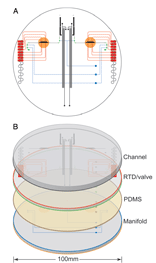Inspired by Mars exploration, DNA sequencing gets much smaller, may be ready for field work soon
 ABI’s smallest sequencer is about the size and weight of a house air conditioning unit [ABI 310: 95 kg (208 lbs); 61 x 56 x 86 cm (24 x 22 x 34 in)]. Researchers who developed the Mars Organic Analyzer for detecting extraterrestrial life recently turned their attention to DNA sequencing. In 9 May 2006 PNAS Blazej, Kumaresan, and Mathies from the University of California, Berkeley, report on a microfabricated DNA sequencer comprised of three 10 cm glass wafers. Using 1 femtomole of DNA template and a 250 nanoliter reaction chamber, the device performs thermal cycling, DNA purification, and capillary electrophoresis, generating reads of up to 556 bases with 99% accuracy. Based on their results “the template/reagent requirements can be reduced an additional 100-fold, and a fully integrated microfluidic genomic sequencing system should also lead to significant infrastructure and labor savings.”
ABI’s smallest sequencer is about the size and weight of a house air conditioning unit [ABI 310: 95 kg (208 lbs); 61 x 56 x 86 cm (24 x 22 x 34 in)]. Researchers who developed the Mars Organic Analyzer for detecting extraterrestrial life recently turned their attention to DNA sequencing. In 9 May 2006 PNAS Blazej, Kumaresan, and Mathies from the University of California, Berkeley, report on a microfabricated DNA sequencer comprised of three 10 cm glass wafers. Using 1 femtomole of DNA template and a 250 nanoliter reaction chamber, the device performs thermal cycling, DNA purification, and capillary electrophoresis, generating reads of up to 556 bases with 99% accuracy. Based on their results “the template/reagent requirements can be reduced an additional 100-fold, and a fully integrated microfluidic genomic sequencing system should also lead to significant infrastructure and labor savings.”
Faster, cheaper, more portable sequencing should facilitate “point-of-use” DNA barcoding devices for identifying specimens in the field, detecting invasive species at the customs station, and sorting through museum drawers for undescribed species, for example.
This entry was posted on Wednesday, May 10th, 2006 at 9:42 pm and is filed under General, Papers. You can follow any responses to this entry through the RSS 2.0 feed. Both comments and pings are currently closed.
May 15th, 2006 at 5:24 am
I want my Tricorder now:)
Keep up the good work.